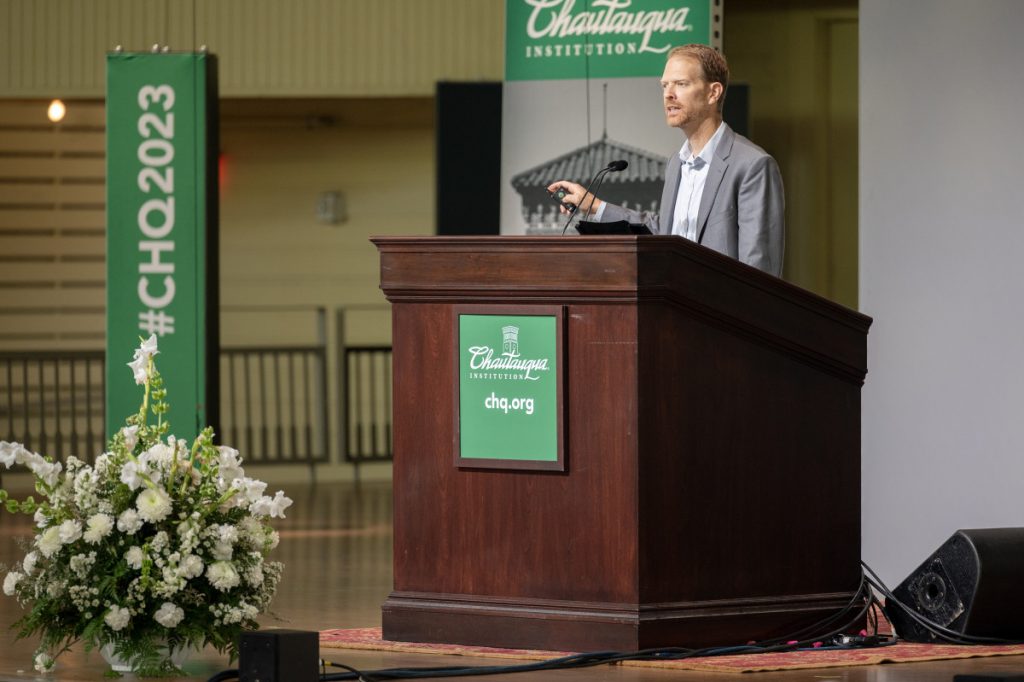
Alton Northup
Staff writer
Joel Dunn does not just visit parks; he builds them.
As president and CEO of Chesapeake Conservancy, a nonprofit advocating for the creation of the Chesapeake National Recreation Area, Dunn has devoted his career to preserving the nature and history of the Chesapeake Bay by establishing it as the 425th unit under the National Park Service. He presented his lecture, “Chesapeake Bay: A 21st Century Park,” at 10:45 a.m. Thursday in the Amphitheater to continue the Chautauqua Lecture Series Week Seven theme, “The National Parks: How America’s ‘Best Idea’ is Meeting 21st-Century Challenges.”
Chesapeake Bay is the largest estuary in the United States, and its drainage basin extends into six states. The bay has long been known for its wildlife and beauty. Explorer John Smith, who mapped the area in 1607, noted its plentiful fish and concluded “heaven and Earth never agreed better to frame a place for man’s habitation.”
The bay was also “the cradle of a new America,” Dunn said. Its landscape served as background to the Siege of Yorktown in 1781, the bombardment of Fort McHenry observed by Francis Scott Key in “The Star-Spangled Banner” and Harriet Tubman’s underground railroad.
But now a crisis looms over the Chesapeake. Pollution from development and agriculture along the waters have created excess nitrogen and phosphorus, fueling harmful algal blooms that kill wildlife. The Chesapeake oyster “has been decimated by overharvest,” falling to 1% of historic levels, and the crab population reached a historic low in 2020, Dunn said.
“Our mismanagement of the ecosystem has led to a virtual collapse of our noted species,” he said. “We’re losing open spaces and sites of national interests; we have rising seas from human-caused climate change, which is hitting marginalized communities, submerging our wetlands and erasing small towns.”
On the bright side, efforts to preserve the environment have been underway for more than 40 years, including the creation of 17 national wildlife refuges, five national scenic and historic trails, two national forests, national heritage areas, a new national marine sanctuary, oyster sanctuaries, hundreds of state parks and numerous units of the National Park System. However, none of these are devoted to preserving the bay.
Dunn estimated that in order to preserve the integrity of the ecosystem, 50% of the Chesapeake’s land and water needs to be protected. Currently, just 23% – or 64,000 square miles – are protected, and his organization has called to protect 30% by 2030.

To do this, he wants to establish the Chesapeake National Recreation Area; the area would utilize a collection of voluntary partnerships with existing parks, states, localities, tribal land and private entities. U.S. Sen. Chris Van Hollen (D-Md.) and U.S. Rep. John Sarbanes (D-Md.) introduced legislation in late July to designate the area.
“We’re closer than ever to permanent, world-class protection and recognition for one of the most important geographical and historical features in the nation,” Dunn said. “The Chesapeake is as spectacular as Yellowstone or Yosemite; it’s as great as the Great Smokies; it’s as grand as the Grand Teton.”
But building a park in the 21st century is different than in the past and requires a bottom-up approach, Dunn said. Prior to drafting the bill, Van Hollen and Sarbanes held working groups that included stakeholders to find a solution that worked for everybody. A coalition of supporters formed, including mayors, foundation leaders, nonprofit leaders, religious leaders, tribal leaders, outdoor equipment company REI and the National Parks Conservation Association, whose president Theresa Pierno closes Week Seven today.
The history of Indigenous people, Black people and watermen who call Chesapeake home will be at the forefront of the area while balancing conservation and responsible tourism, Dunn said.
“The Chesapeake Bay is so revered, it’s seen as a spiritual being,” he said. “The political, social and spiritual concepts of tribal nations were and remain interdependent with specific geographic areas. I’ve learned from tribal leaders that removing Indigenous people from that place harms the fabric of their culture and made them refugees.”
In April 2022, the Chesapeake Conservancy bought 465 acres of land on the Rappahannock River and returned it to the Rappahannock Tribe. The land, called Fones Cliffs, is the ancestral home of the tribe.
Also in 2022, the Chesapeake Conservancy, the City of Annapolis, Blacks of the Chesapeake Foundation, and the state of Maryland entered into an agreement with The Conservation Fund to acquire property known as Elktonia-Carr’s Beach. The property is the last remnant of beaches that welcomed Black people during the time of segregation. Dunn said that recognizing the historic discrimination against Black people, including slavery, is important for fully understanding the area.
“Our collective future depends on reversing the loss of nature,” Dunn said. “We need an inspired constituency that includes everyone. The parks we create today can and must do it all.”




